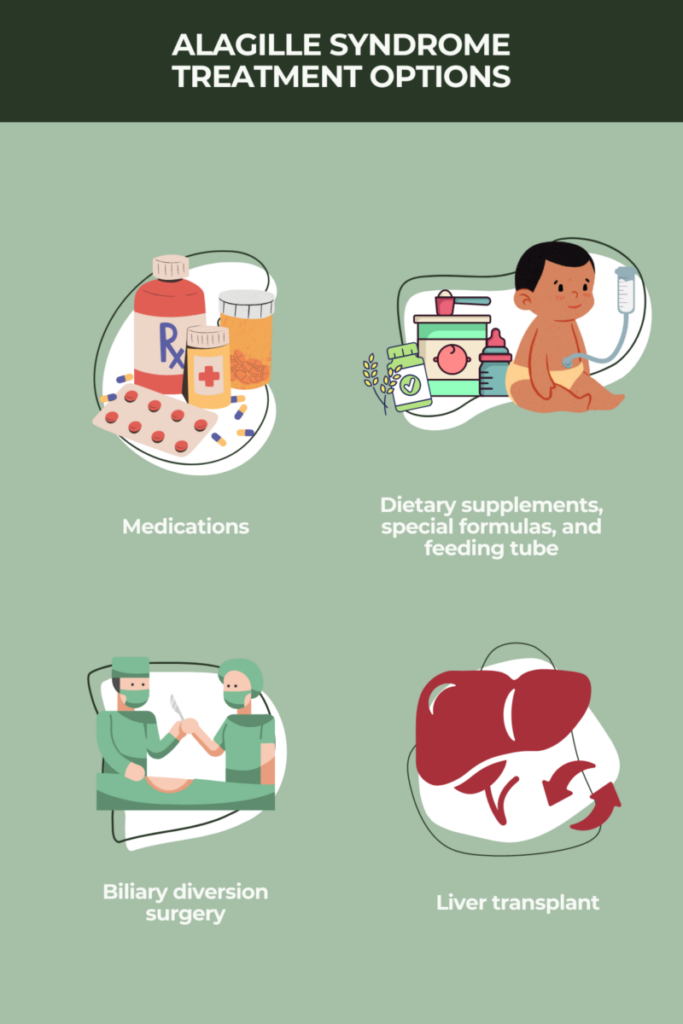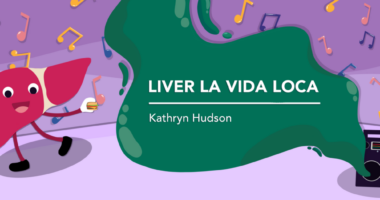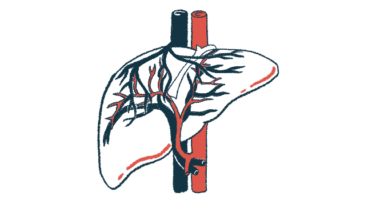Alagille syndrome treatment
Last updated Feb. 1, 2024, by Marisa Wexler, MS

There is currently no cure for Alagille syndrome, but a range of treatment options, including medications and surgical procedures, are available for managing Alagille syndrome symptoms and improving quality of life for patients. Resources such as support groups also can help patients and their families navigate life with Alagille.
Alagille syndrome is a rare genetic disorder mostly caused by mutations in the JAG1 gene, although mutations in another gene called NOTCH2 contribute to a minority of cases. The condition is marked by abnormalities in development, which usually include liver problems, heart defects, and a characteristic facial shape, among other symptoms.
Understanding Alagille syndrome
Alagille syndrome can cause a range of symptoms, and each person has a different experience with the disease — even people within the same family can have very different signs and symptoms. As such, care is highly personalized, depending on the patient’s individual needs.
Virtually all people with Alagille have liver disease. In particular, a characteristic feature of the disorder is intrahepatic bile duct paucity, wherein the liver has fewer bile ducts than normal.
Bile is a fluid produced by the liver that helps break down certain fatty molecules and proteins during digestion, and also helps with disposing of certain waste products. Bile ducts are a series of tubes that normally carry bile from the liver to the gallbladder, an organ under the liver where bile is stored, and to the small intestine, where it’s used to help digest foods.
In Alagille syndrome, the lower number of bile ducts can reduce or obstruct the flow of bile from the liver, a condition known as cholestasis. This may cause bile to build up in the liver, which can result in liver damage, as well as symptoms such as itching due to excess bile in the bloodstream. These symptoms are often similar to those in another liver disease called biliary atresia.
Heart problems are also a common feature of Alagille syndrome. Most patients have pulmonary artery stenosis, which is an abnormal narrowing of the pulmonary artery that carries blood from the heart to the lungs. More severe cardiac defects, including pulmonary atresia, where the valve that connects the heart to the pulmonary artery is absent, and a complex heart defect called tetralogy of Fallot, also can occur with Alagille syndrome.
Other symptoms of Alagille may include distinctive differences in the shape of the face, abnormalities in eyes and bone development, and problems with the kidneys and blood vessels.
Because Alagille syndrome usually affects multiple systems throughout the body, a multidisciplinary approach is typically required for optimal care, with different specialists helping to address specific disease manifestations.
Medication and supportive care
No Alagille syndrome treatments are available that can cure the disease or address its underlying cause. A number of medications, supplements, and other approaches can ease certain disease manifestations, including the buildup of bile and itching, and nutritional deficiencies.
Treatments for itching
In recent years, two medications have been approved by the U.S. Food and Drug Administration (FDA) specifically to treat itching in Alagille syndrome. They are:
- Livmarli (maralixibat), sold by Mirum Pharmaceuticals, is approved in the U.S. for Alagille patients 3 months and older and in Europe for those ages 2 months and older
- Bylvay (odevixibat), sold by Ipsen, is approved in the U.S. for patients 1 year and older, and the company has plans to seek its approval in Europe.
Both of these oral therapies work to block an enzyme that carries bile acids from the intestine back to the blood and liver, increasing the amount of bile acids that are excreted in stool. Itching in Alagille syndrome is mostly caused by the buildup of bile acids in the blood. By reducing bile acid levels, the therapies can ease this symptom.
In addition to these two approved medications, a few other therapies may be used off-label to help manage pruritus and related liver symptoms in Alagille patients:
- ursodeoxycholic acid (UDCA), sold as Urso and Actigall among other brand names, helps reduce the buildup of bile in the liver by making it more soluble in water, thereby boosting bile flow
- cholestyramine, sold under the brand names Prevalite and Locholest, with several generics also available, helps lower bile acid levels by increasing their excretion in feces
- rifampicin, an antibiotic sold under the brand name Rifadin among others, is believed to prompt a modification in bile acids that reduces the sensation of itch and increases their ability to be excreted by the kidneys
- naltrexone, sold as Vivitrol and several generics, works by blocking opioid receptors in the body, which are believed to mediate how the brain senses the feeling of itch.
Other medications may be given as adjunctive, or add-on, treatment to help manage itch in Alagille syndrome patients, including antihistamines such as diphenhydramine (sold as Benadryl, among others) and selective serotonin reuptake inhibitors such as sertraline (sold as Zoloft, among others).
Nutrition therapy
Liver dysfunction in people with Alagille syndrome frequently leads to malabsorption, wherein the body isn’t able to digest and absorb certain nutrients properly, which can contribute to growth deficiencies.
Malabsorption in Alagille syndrome commonly makes it harder for the body to absorb certain fat-soluble nutrients, including vitamins A, D, E, and K. As such, supplements of these vitamins are often given to ensure patients can get enough into their systems.
To ensure patients are getting enough nutrients to thrive, it’s generally recommended that people with Alagille syndrome eat a high-calorie diet, with at least 25% more daily calories than is recommended for someone in the general population.
Food or formula containing medium chain triglycerides — a type of fat molecule that can typically be digested well in people with the condition — is also recommended. These fat molecules are naturally found in coconut oil, milk fat, and palm kernel oil; synthetic versions of these fats are also present in some specialty medical food formulations.
If children with Alagille are not ingesting enough calories and nutrients to support their growth, a healthcare provider may recommend a feeding tube. This can be either inserted through the nose into the stomach — called a nasogastric tube — or placed directly into the stomach through a small opening in the abdomen, known as a gastrostomy tube.
Additional treatments
Other treatments may be used to manage specific manifestations of Alagille syndrome, similar to how those manifestations would be treated for people without the condition.
For example, if pancreas function is reduced, patients may be given supplements of pancreatic enzymes to aid in digestion, while patients with renal tubular acidosis (abnormal acidity in the kidneys) may receive therapies to reduce blood acidity levels.
Eye abnormalities in Alagille syndrome normally don’t cause notable problems with vision that require treatment, but if problems o occur, specialized ophthalmological care may be given to address the issue.
Investigational therapies
Takeda is developing an experimental Alagille syndrome treatment, dubbed TAK-625, that contains a formulation of maralixibat, the same active agent in Livmarli. The once-daily oral therapy is being tested in a Phase 3 trial (NCT05543174), the main goal of which is to evaluate how TAK-625 affects levels of bile acids in the blood. Other measures, including the treatment’s effect on itching, will also be assessed.
The Mayo Clinic is running a Phase 2 study (NCT04256759) testing the anti-inflammatory therapy dupilumab in people with moderate to severe chronic itching due to liver diseases such as Alagille syndrome. Dupilumab blocks the activity of an inflammatory signaling molecule called interleukin-4. It’s approved in the U.S. to treat a chronic skin condition marked by intense itch, called prurigo nodularis, and is marketed under the name Dupixent.
Children’s Hospital of Fudan University, China is conducting a Phase 4 clinical trial (NCT05488067) to test whether atorvastatin, a medication approved to lower cholesterol, may help reduce the formation of xanthomas in people with Alagille syndrome. These are waxy skin lesions that develop due to the abnormal buildup of cholesterol and fats underneath the skin.
Theoretical approaches to target the root cause of Alagille syndrome, such as gene therapies, RNA-based treatments, or gene editing treatments, have been proposed by scientists, but so far none of these strategies has been tested in people.
Surgery
In some cases, medications alone may not adequately control the symptoms of Alagille syndrome and doctors may recommend certain surgeries to help patients regain some quality of life. These may include procedures such as biliary diversion, which diverts the flow of bile, or a liver transplant in severe cases when the liver is no longer functioning properly.
Surgeries may also be recommended to correct certain heart defects, as well as other organ or blood vessel abnormalities in people with Alagille.
Biliary diversion
When itching in Alagille syndrome cannot be managed with medication alone, a surgical procedure called biliary diversion may be performed. The basic aim of biliary diversion is to redirect the flow of bile to help prevent the buildup of bile acids that drive itching.
The most common type of biliary diversion in Alagille syndrome is known as partial external biliary diversion, or PEBD. In PEBD, an opening is formed from the gallbladder to the outside of the abdomen, which can then be used to drain bile out of the body.
Less commonly, internal biliary diversion, where bile flow is redirected within the body, or ileal exclusion, which involves shortening the small intestine to promote the excretion of bile, also may help remove bile in Alagille syndrome.
Liver transplant
If liver disease in Alagille syndrome becomes serious and leads to organ failure, a liver transplantation is frequently required. Liver transplant is a surgical procedure wherein a person’s diseased liver is replaced with a healthy liver, either a whole liver from a deceased donor or part of one from a live donor.
It’s estimated that up to a third of Alagille syndrome patients will require a liver transplant, mostly due to complications of cholestasis such as severe itching. In most cases, the procedure is required before the patient reaches adulthood.
Heart surgery
When heart problems in Alagille syndrome require intervention, surgery is typically used to correct the heart defects.
The specific type of cardiac surgery will depend on the patient’s condition and the kind of defect. For instance, pulmonary artery stenosis may be treated with balloon angioplasty, wherein a balloon is inserted to help open the narrowed artery. Invasive open-heart surgeries are often needed to repair more complex defects such as tetralogy of Fallot, however.
Liver Disease News is strictly a news and information website about the disease. It does not provide medical advice, diagnosis or treatment. This content is not intended to be a substitute for professional medical advice, diagnosis, or treatment. Always seek the advice of your physician or other qualified health provider with any questions you may have regarding a medical condition. Never disregard professional medical advice or delay in seeking it because of something you have read on this website.
Recent Posts
- Compound found in honey reduced inflammation in PBC mice in lab
- I have patient compliance to thank for my normal MELD lab results
- Heart complications common in children with PFIC, study finds
- Soaking in the season of joy is extra special this year
- FDA authorizes use of 1st AI tool to speed MASH clinical trials
Related articles






